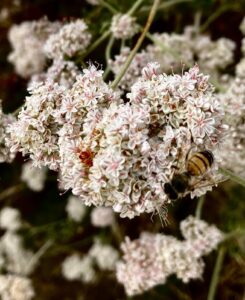 As we at St Paul’s Cathedral move beyond the words of our Land Acknowledgment, our clergy prepare for the recognition of October 14 Indigenous Peoples Day with our October 13 Sunday services. As a part of our journey beyond a land acknowledgment, this practice of prayer calls to mind the tending of native plants that grow throughout this stolen land we call home.
As we at St Paul’s Cathedral move beyond the words of our Land Acknowledgment, our clergy prepare for the recognition of October 14 Indigenous Peoples Day with our October 13 Sunday services. As a part of our journey beyond a land acknowledgment, this practice of prayer calls to mind the tending of native plants that grow throughout this stolen land we call home.
Hamill, as it is known to our Kumeyaay neighbors, or California Buckwheat, is a lovely example of a plant rich in resilience and imbued with many culinary and medicinal properties that has made it essential to the local Indigenous community over thousands of years. It even offers a seasonal reminder: when the flowers turn from white to red, “it signals that the time has come to head up to the mountains for the pine nut harvest….”1
Through such traditions, our Kumeyaay siblings have known the importance of being one with the land, tending the plants that nurture life. At this time of climate chaos, we would do well to learn from their centuries of wisdom.
Living alongside lifegiving creation, being one with the Earth: this is what it means to love God through creation. When we forget this, we lose sight of how everything is connected. Through our worship, we recall that we are all children of God and, as such, responsible to love one another and care for our environment and all that dwells therein. As we consider what gives life we can become more attuned to how to form just relationships instead of hierarchical ones, how we can protect instead of “develop” the land: actually, where our true treasure lies. Our prayer leads us to a thirst for such knowledge.
At St Paul’s we move from a land acknowledgment with words to understanding through education as this month we study Sarah Augustine’s book, The Land is Not Empty: Following Jesus in Dismantling the Doctrine of Discovery. Twenty participants from several congregations are learning about the destructive Doctrine of Discovery that has harmed the original people and land of this and a multitude of other countries. This was done in the name of our own Christian faith with the end result of death and devastation through greed and power.
Bradley Hauf (Oglala Sioux, Lakota), The Episcopal Church Missioner for Indigenous Ministries, tells us:
Replacing Columbus Day with Indigenous Peoples Day allows for the acknowledgment of Indigenous people in this country and what happened to us. It allows for truth-telling. It promotes an honest examination of our past. It dispels the myth and the atrocity of white dominance. It tells Indigenous people that we are not relics of the past, that we are very much still here, and we are a significant part of the American story. The church should be a central part of making this transition happen.
As we learn about the Doctrine of Discovery, we find agency in this knowledge. Thus our prayer and new knowledge leads us to action. As a community of faith, how shall we proceed?
1Wilken-Robertson, Kumeyaay Ethnobotany: Shared Heritage of the Californias, Sunbelt Publications, 2018, San Diego, California, p.165
2 For St Paul’s Land Acknowledgment, scroll to bottom at https://stpaulcathedral.org/#
Members of St Paul’s 2019-2020 Sacred Ground sessions and Indigenous-themed book studies are invited to join the 10/21 Virtual Book Study when author Sarah Augustine, the Co-Founder and Executive Director of The Coalition to Dismantle the Doctrine of Discovery, joins the conversation. For more information, contact dianelopezhughes@gmail.com
Photo: California Buckwheat, Mission Trails Regional Park, author’s photo


zvlitd